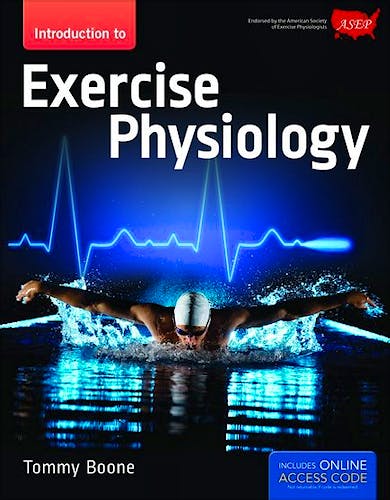

No hay productos en el carrito



Introduction to Exercise Physiology + Online Access
Boone, T.
1ª Edición Mayo 2013
Inglés
Tapa blanda
532 pags
1200 gr
22 x 28 x 3 cm
ISBN 9781449698188
Editorial JONES AND BARTLETT
LIBRO IMPRESO
-5%
59,40 €56,43 €IVA incluido
57,12 €54,26 €IVA no incluido
Recíbelo en un plazo de
2 - 3 semanas
Description
The Introduction to Exercise Physiology, identifies the key scientific content that is critically important to the successful practice of exercise physiology. This text focuses on the profession of exercise physiology by introducing students to the scientific basis for the practice of exercise physiology to prevent or control mind-body diseases, promote health and well-being, and enhance athlete performance. The goal of this text is to embrace a new paradigm of exercise physiology as a comprehensive healthcare profession and not as a one-course experience.
Introduction to Exercise Physiology is endorsed by The American Society of Exercise Physiologists (ASEP) a national non-profit professional organization committed to the advancement of exercise physiologists. The text emphasizes sound scientific content that will help exercise physiologists design appropriate exercise prescription that focuses on the public health challenges of a sedentary lifestyle. Students will learn the necessary physiologic, electrocardiographic, biomechanic, and anatomic concepts pertinent to prepare for and pass the ASEP Board Certification exam. In addition, the text enables students to understand the ethics of sports nutrition and athletic performance, by examining exercise metabolism, fuel utilization, and cardiovascular functions and adaptations from a non-performance enhancing supplement perspective. Specific physiologic calculations are presented to teach students how to monitor exercise intensity, as well as to improve the safety and credibility of client-specific test protocols, health and fitness training programs, and athletic competitions.
To support the “exercise as medicine” approach of the text it is
organized into seven major areas:
Part I Scientific Aspects of Exercise Physiology
Part II Training the Cardiorespiratory and Muscular Systems
Part III Training and Performance
Part IV Exercise Is Medicine
Part V Exercise Biomechanics
Part VI Anatomy of Sports and Exercise
Part VII The Profession of Exercise Physiology
Highlights
Discussion of the importance of professionalization in Exercise Physiology
Comprehensive overview pertaining to the legal aspect of Exercise Physiology
Coverage of the challenges that lie ahead for exercise physiologists including
the basics of the change process
Comprehensive and thorough exam prep for the ASEP Board Certification Exam
Features & Benefits
Chapter Objectives found at the beginning of each chapter encourage students
to answer questions as they read
Close Up Boxes contain unique information that highlights and reinforces core
concepts
Key Point Boxes are designed to bring attention to current issues and trends
In Summary is found at the end of each chapter and helps students remember important
content
Review Questions encourage students to think critically about chapter content
Metabolic Computations found in the measurement-driven chapters demonstrate
the student’s understanding of core physiology concepts
Applicable Courses
The book is intended for undergraduate exercise physiology courses in exercise
science, kinesiology, human performance, sports sciences, health and human performance;can
also be used at the graduate level too.
Table of Contents
Part 1 Scientific Aspects of Exercise Physiology
Chapter 1 Regulation of Ventilation
Chapter 2 Pulmonary Ventilation
Chapter 3 Cardiovascular System
Chapter 4 Maximal Oxygen Uptake
Chapter 5 Biochemistry of Exercise
Chapter 6 Neuromuscular System
Part 2 Training the Cardiorespiratory and Muscular Systems
Chapter 7 Training the Aerobic and Anaerobic Energy
Chapter 8 Training the Muscular System
Part 3 Training and Performance
Chapter 9 Ethical Thinking and Sports Nutrition
Chapter 10 Agents to Enhance Physiologic Responses to Exercise
Part 4 Exercise Is Medicine
Chapter 11 Electrocardiography
Chapter 12 Cardiovascular Assessment and Health Profile
Chapter 13 Exercise and Health Benefits
Part 5 Exercise Biomechanics
Chapter 14 Basic Concepts in Exercise Biomechanics
Chapter 15 The Science of Levers
Chapter 16 Exercise Biomechanical Calculations
Part 6 Anatomy of Sports and Exercise
Chapter 17 Muscles of the Upper Extremity
Chapter 18 Muscles of the Lower Extremity
Chapter 19 Applied Anatomy and Human Movement
Part 7 The Profession of Exercise Physiology
Chapter 20 Introduction to Exercise Physiology
Chapter 21 Professionalization of Exercise Physiology
Chapter 22 Legal Aspects of Exercise Physiology
Chapter 23 Exercise Physiology Research
About the Authors
Tommy Boone-Professor, The College of St. Scholastica, Duluth,
Minnesota
Tommy Boone, PhD, MPH, MAM, MBA Professor, Department of Exercise Physiology
The College of St. Scholastica
© 2025 Axón Librería S.L.
2.149.0